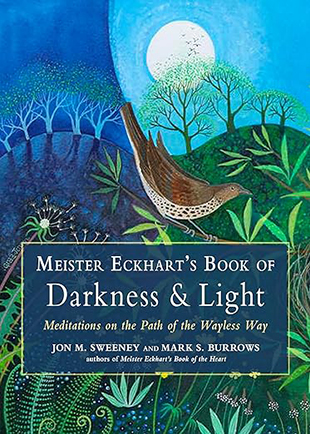Meister Eckhart (1260–1328) was a Dominican priest, scholar, teacher, preacher, and mystic. In his day he took some unconventional positions, which put him at odds with the Church; he was even labeled a heretic. In our day, he is admired for his imaginative takes on the divine mystery, including his promotion of paradox as an essential understanding.
But Eckhart is not for everyone. In the introduction to this book, we are told that those who want a straight path toward a defined goal, led by a guide who tells them exactly what to do and what not to do, will not resonate with his teaching. But “if you can imagine what it might mean to set out on a ‘wayless way,’ not one mapped by tired orthodoxies or mindless strategies, then Eckhart might be the Meister – or ‘master’ – you have been looking for. Perhaps even the one you deserve. And surely one of the ones you need.”
Jon M. Sweeney, an independent scholar and Spirituality & Practice’s Contributing Editor for Books and New Media, and Mark S. Burrows, a poet, translator, and professor of religion and literature at the Protestant University of Applied Sciences in Bochum, Germany, have taken up the challenge of bringing Eckhart’s thought to contemporary audiences. They don’t simplify it (as some seekers might want them to do); instead they identify key themes and present them through inspiring and encouraging poetry. Eckhart was not a poet, but his ideas are very suited to the genre.
Sweeney and Burrows call these poems “re-voicings of Eckhart’s thought drawing on key images, phrases, and ideas found in his writings.” At the end of the book, they provide extensive notes identifying the specific sources behind each poem. This is an invaluable addition for both scholars and intrigued seekers.
The poems – they really do invite meditation as the book’s subtitle suggests – are organized in four sections: (1) In the Beginning . . . Darkness, (2) Embracing Darkness, (3) Awakening to Light, and (4) Living in the Radiance.
The first step on the wayless way is in darkness – your darkness. Only from there can you see the light.
“I’ve said many things, but at the heart
of them all is this: There is a light
within you, in your soul, uncreated
and uncreatable; it simply is.
“If you wish to know yourself,
look for this light in the dark;
it is ever present, even when
you’ve lost sight of it. Look
away from what you think
you are, and look deeper into
the darkness that is within.
“There you’ll find that light
which is ever radiant,
even if no one – not
even you – notices.”
Other meditations refer to unknowing, becoming empty, and letting go. You will discover that “nothing is far from God; everything is always in God. I’d even say that everything is God.” But to get this, you probably need to change:
“We talk and talk and talk, and all
this brings us no closer to wisdom.
“If you wish to understand the deep
truth that is in God and in yourself,
“keep still and listen; become poor
in yourself, desiring nothing and
“knowing nothing and possessing
nothing. Only when you are empty
of all your chatter will there be
room enough in you to receive
“the gift of wisdom you long for.”
We were surprised to find some humor, or a twinkling of the eye, in some poems, such as:
“It is God’s
promise that all
your pain will
one day be
turned into joy.
“This may not
comfort you now,
but that is the
point of hard-to-
understand truth.”
And some use nature imagery to paint a picture of the spiritual life:
“God’s pure being so draws us that,
small as we are –
like caterpillars who fall
from the trees and slowly
begin to make
their return
to that prior height –
we climb.
In that life
we see our lives,
in the brilliance
of the midday sun.”
We can only give you a taste of Eckhart in a review. And you may find, as we did, that the best way to approach it is to simply open to a page at random and spend some time with it. And then, be sure to check out Sweeney’s and Burrows’ other two books in this series:
Meister Eckhart’s Book of Secrets and Meister Eckhart’s Book of the Heart.
